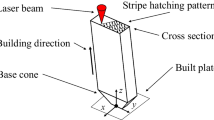Abstract
A systematic investigation of the fretting fatigue behavior of the titanium alloy Ti-6Al-4V in both the mill-annealed (MA) and the solution-treated and overaged (STOA) conditions was carried out. A sphere-on-flat fretting fatigue device was used that facilitated real-time control and monitoring of all the relevant parameters such as the contact geometry, contact (normal and tangential) loads, and bulk alternating stress. While different sets of experiments were conducted to examine the influence of the bulk stress, the tangential load, and the normal load, respectively, on fretting fatigue response, the effect of microstructure on fretting fatigue was explored with experiments on the acicular, Widmanstätten, and martensitic microstructures as well. In experiments where the contact loads were maintained constant and the bulk stress was varied, fretting reduced the fatigue strength of Ti-6Al-4V. For this case, the “strength reduction factor” was higher for the experiments with higher tangential loads. For cases where the bulk stress and the normal or the tangential loads were maintained constant, lower fretting fatigue lives were obtained at larger tangential loads and at smaller normal loads. Of all the microstructures studied, preliminary results on the martensitic structure suggest an enhanced fretting fatigue resistance, compared to the basic STOA or the MA microstructure. Using the measured maximum static friction coefficient for Ti-6Al-4V, the experimentally observed contact and stickzone radii were found to exhibit good agreement with analytical predictions. Furthermore, conditions for crack initiation were determined through the application of the recently developed adhesion model for fretting fatigue. The model predictions of weak adhesion and crack initiation were validated with experimental observations of stick-slip behavior and fretting fatigue failures, respectively.
Similar content being viewed by others
References
R.B. Waterhouse: Fretting Fatigue, Applied Science Publishers, London, 1981.
R.B. Waterhouse and T.C. Lindley: Fretting Fatigue, European Structural Integrity Society Publication 18, London, 1994.
R.B. Waterhouse: Int. Mater. Rev., 1992, vol. 37, pp. 77–97.
T.C. Lindley: Int. J. Fatigue, 1997, vol. 19, pp. S39-S49.
I.V. Papadopoulos, P. Davoli, C. Gorla, M. Filippini, and A. Bernasconi: Int. J. Fatigue, 1997, vol. 19, pp. 219–35.
A.E. Giannakopoulos, T.A. Venkatesh, T.C. Lindley, and S. Suresh: Acta Mater., 1999, vol. 47, pp. 4653–64.
B.U. Wittkowsky, P.R. Birch, J. Dominguez, and S. Suresh: Fatigue Fracture Eng. Mater. Structures, 1999, vol. 22, pp. 307–20.
B.U. Wittkowsky, P.R. Birch, J. Dominguez, and S. Suresh: in Fretting Fatigue: Current Technology and Practices, ASTM STP 1367, D.W. Hoeppner, V. Chandrasekaran, and C.B. Elliot, eds., ASTM, Philadelphia, PA, 1999, pp. 213–27.
A.L. Hutson, T. Nicholas, and R. Goodman: Int. J. Fatigue, 1999, vol. 21, pp. 663–69.
R. Cortez, S. Mall, and J.R. Calcaterra: Int. J. Fatigue, 1999, vol. 21, pp. 709–17.
S. Goto and R.B. Waterhouse: in Titanium ′80: Science and Technology, H. Kimura and O. Izumi, eds., TMS, Warrendale, PA, 1980, vol. 3, pp. 1837–44.
P. Blanchard, C. Colombie, V. Pellerin, S. Fayeulle, and L. Vincent: Metall. Trans. A, 1991, vol. 22A, pp. 1535–44.
J.A. Hines and G. Lütjering: Fatigue Fract. Eng. Mater. Structures, 1999, vol. 22, pp. 657–665.
R.S. Bellows, S. Muju, and T. Nicholas: Int. J. Fatigue, 1999, vol. 21, pp. 687–697.
H. Hertz: J. Reine. Angewandte Mathematik, 1882, vol. 92, pp. 156–71.
R.D. Mindlin: J. Appl. Mech., 1949, vol. 16, pp. 259–68.
V.K. Semenchenko: Surface Phenomena in Metals and Alloys, Addison-Wesley, Reading, MA, 1962.
J.S. McFarlane and D. Tabor: Proc. R. Soc., London, 1950, vol. A202, pp. 244–53.
R.O. Ritchie, B.L. Boyce, J.P. Campbell, O. Roder, A.W. Thompson, and W.W. Milligan: Int. J. Fatigue, 1999, vol. 21, pp. 653–62.
B. Cottrell and J.R. Rice: Int. J. Fracture, 1980, vol. 16, pp. 155–69.
J.C. Newman and I.S. Raju: Eng. Fracture Mech., 1981, vol. 15, pp. 185–92.
G.R. Yoder, L.A. Cooley, and T.W. Crooker: in Fracture Mechanics: 16th Symp., ASTM STP 868, M.F. Kanninen and A.T. Hopper, eds., ASTM, Philadelphia, PA, pp. 392–405.
G. Welsch, R. Boyer, and E.W. Collings: Materials Properties Handbook: Titanium Alloys, ASM International, Materials Park, OH, 1995.
R.A. Antoniou and T.C. Radtke: Mater. Sci. Eng. A, 1997, vol. 237, p. 229.
Author information
Authors and Affiliations
Rights and permissions
About this article
Cite this article
Venkatesh, T.A., Conner, B.P., Suresh, S. et al. An experimental investigation of fretting fatigue in Ti-6Al-4V: the role of contact conditions and microstructure. Metall Mater Trans A 32, 1131–1146 (2001). https://doi.org/10.1007/s11661-001-0124-8
Received:
Issue Date:
DOI: https://doi.org/10.1007/s11661-001-0124-8




